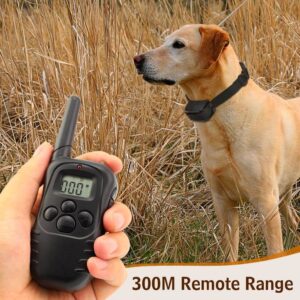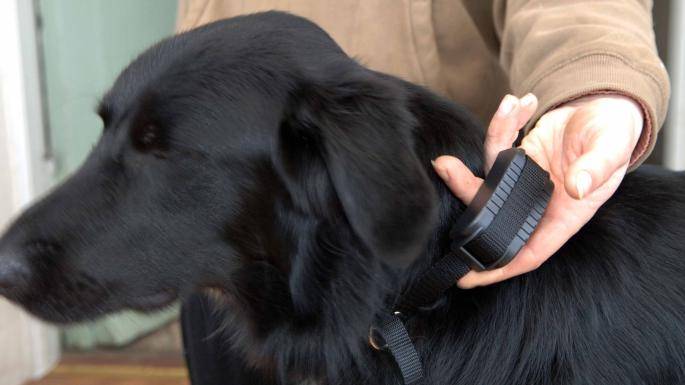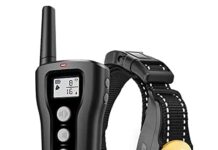A training shock collar can be used on the Puppy from 10 weeks old, but it is recommended only in exceptional cases.
Try different learning types, like with a child, to learn your little Puppy’s basic commands.
Try positive and negative reinforcement or rewards when he reacts positively to the given command before using training collars.
There is a big market for dog training collars, and some are qualified for young puppies from 8 to 10 weeks; collars are used early for anti-bark learning that delivers little shock and vibration when your Puppy starts barking.
Read Next – Educator E-Collar Remote Dog Training Collar
When should you use a shock collar?
Puppy problems are barking, running away, chewing furniture, toilet training, and other undesirable behaviors for the puppy owners.
After a few times, your Puppy will feel a disagreeable sensation in the training collar and stop doing the activities.
This is commonly used by puppy owners when the dog is left home alone during the day, and having a barking dog all day is not acceptable.

Training a shock collar too early is too dangerous for the Puppy.
If you use force in the Puppy’s training collar, he can develop stress and anxiety, and you don’t want your Puppy to feel that way.
Positive reinforcement can not hurt your Puppy and make him feel stressed like a shock collar at a young age.
When should you start using a training collar on a dog?
Alternative learning methods can be used on the puppies when you want to train or teach them something new.
A shock collar must be the last option to apply for a learning puppy.
The shock collar adds additional stress to the Puppy, which will cause him to experience constant fear, which will change him in a second.
Shock training collars are recommended for use at a later age. You can use one when your Puppy is fully trained with the basics, responds well to the basic commands, and starts the advanced training.
Is shock collar training practical?
A training collar should be a distance command tool when your dog cannot hear you.
A training shock collar should reinforce the well-known commands so you don’t confuse your pet.
Recommended: Bark Collar on 8-Week-Old Puppy
A shock collar will give you fast results, only a few shocks away for your dog to correct the unwanted behavior.
Aftershock stimulation only takes a beep signal or vibration to warn him, which is enough. Shock collars are also suitable for keeping a dog in the yard, giving him freedom and safety at the same time.
If you use a shock collar for barking at the older dog, you can use it with effect even when you are not at home.
They have an auto-correcting mode that you can set while you are away. We do not recommend leaving your dog alone when the training collar is in auto mode.

The training collar causes shock. You are using an aversive behavior modification that can shock your pet and cause him to give you negative feedback.
A dog can start to fear people, objects, sounds, and other stuff that he will associate with the collar stimulation he gets from you.
Overcorrection is a big problem when using a training collar; when the shock is sent to your dog, mechanical collar stimulations can shock him unintentionally or too many times, confusing him and causing problems with his behavior.
Lack of positive reinforcement and rewarding system – if your dog gets your affection, verbal approval, or a tasty treat, he will be happy.
A shock collar can deter negative behavior but will not reward him when he does something good.
If you use a shock collar first, let your dog wear it for one week before turning it on. Please don’t use the collar immediately when you put it on him so that he will associate it with positive things during that time.
You are trying to get your dog to think that negative behavior is causing the shock he feels, not the collar he wears when you turn the training collar on. Please start at the lowest stimulation levels to see how he reacts to it when activated.
Read Next – Easy Educator EZ 900 Review
How tight should a shock collar be?
You can slowly try the training collar stimulation level if your dog does not respond to the stimulation. Use the collar to reinforce the commands that he already knows and understands.
Say the command that he knows and wait for his response. If he is not responding, press the button and see what it will be. Reward him as soon as he responds positively to your command.
You need to control your pet’s bad behavior. Use the training collar to manage annoying and aggressive behavior. When he starts doing the activities, turn on the stimulation.
Never hold stimulation on for over three seconds, and push it repeatedly. You want him to learn what he can do and what is banned.
Should a puppy wear a collar all the time?
Don’t let your dog see that you are causing him that unpleasant sensation when he does something wrong; you want him to associate you with the reward and positive reinforcement.
Every Puppy, the dog, is different from every human, and he needs time to learn and develop.
Puppies are fragile; they need time to play and try out their boundaries, and he needs to see what they can or can’t do.
Read Next – Off-Leash Dog Training
At what age can I start e-collar training with my dog?
Is there a recommended age for the introduction of collar conditioning?
Introducing collar conditioning to your dog at the right age is crucial for practical training. Although there is no set age for e-collar training, waiting until the dog is at least six months before starting such training is generally advised.
What is the best age to start e-collar training?
The best age to start e-collar training can vary depending on the individual dog. However, as a general guideline, waiting until your dog is at least six months old ensures they are physically and mentally ready for the training.
Is my dog old enough for shock collar training?
Assessing whether your dog is old enough for shock collar training involves considering their age, maturity level, and overall training needs. It is essential to consult with a professional dog trainer to determine if your dog is ready for this type of training.
How do you start e-collar training with your dog?
What training tools are necessary for e-collar training?
When starting e-collar training, it’s essential to have the necessary tools, including the shock collar itself, and proper guidance and training techniques. A training collar is a valuable tool that aids in teaching and reinforcing desired behaviors.
What are the guidelines for using a shock collar during training?
Proper guidelines for using a shock collar during training include starting with low stimulation levels, gradually conditioning your dog to the collar, and always rewarding good behavior. Consistency and positive reinforcement are key when using a shock collar.
When is a dog old enough to handle shock collar training?
Determining when a dog is old enough to handle shock collar training depends on their age, temperament, and level of responsiveness to training. It is essential to start the training when your dog is mentally and physically developed enough to understand and respond appropriately.
Is a shock collar suitable for puppy training?
Can you use a shock collar for young puppies?
A shock collar is generally not recommended for young puppies due to their delicate age and development stage. Positive reinforcement methods and basic training techniques are more suitable for puppies to establish a strong foundation before considering shock collar training.
At what age should you start introducing a training collar to puppies?
It is advisable to introduce a training collar to puppies once they have reached a more appropriate age and developed basic obedience skills. Beginning with gentle training methods and gradually incorporating a training collar can help puppies adapt comfortably.
Are there specific shock collar age guidelines for puppies?
While there are no strict age guidelines for using shock collars on puppies, it is crucial to prioritize their well-being and development. Consulting with a professional dog trainer can provide valuable insights into the suitable age and training methods for using a shock collar with puppies.
How can a shock collar be used as a training method?
What are the proper ways to start training with a shock collar?
When training with a shock collar, it is essential to begin with positive reinforcement techniques, gradual collar conditioning, and clear communication with your dog. Employing effective training methods ensures a successful and respectful training experience.
How do you let your dog understand the purpose of the training collar?
Helping your dog understand the purpose of the training collar involves consistent communication, patience, and positive reinforcement. Your dog can learn and respond appropriately during training sessions by establishing a clear association between the collar and desired behaviors.
As a dog owner, when should you start training your dog with a shock collar?
As a responsible dog owner, it is crucial to consider your dog’s needs, temperament, and readiness for shock collar training. Seeking guidance from a professional trainer and assessing your dog’s behavior can help determine the appropriate time to start training with a shock collar.
What should you consider before using a shock collar for training?
Are remote training collars safe for dogs?
Remote training collars can be safe for dogs when used correctly and responsibly. Educating yourself on using the collar, following recommended guidelines correctly, and prioritizing your dog’s well-being and comfort during training sessions is essential.
Is my dog ready for e-collar training?
Determining if your dog is ready for e-collar training involves assessing their behavior, responsiveness to commands, and overall training progress. Observing your dog’s readiness and consulting with a professional trainer can help ensure a positive and practical training experience.
What are the risks associated with using shock collars for training?
While shock collars can be effective training tools when used properly, misuse can cause stress, fear, or physical harm to the dog. Understanding the potential risks, implementing proper training techniques, and seeking professional guidance can mitigate these risks and promote a successful training outcome.
Dog Training Collar - Rechargeable Dog Shock Collar w/3 Training Modes, Beep, Vibration and Shock, 100% Waterproof Training Collar, Up to 1000Ft Remote Range, 0~99 Shock Levels Dog Training Set
PATPET Dog Training Collar- Dog Shock Collar with Remote, w/3 Training Modes, Beep, Vibration and Shock, Up to 1000 ft Remote Range, Rainproof for Small Medium Large Dogs.
Dog Shock Collar - Remote Dog Training Collars with 3 Correction Training Modes, Shock, Vibration, Beep, Rechargeable Waterproof E-Collar for Dogs Small, Medium, Large, 1000' Remote Trainer Range
Ankace Shock Collar for Dogs with Remote Dog Training Collar Rechargeable No Bark Collar with Shock Modes Remote Collar Waterproof Shock Collar for Small Medium large dog
Slopehill Dog Training Collar, Waterproof Dog Shock Collar with 2600 Feet Remote, Rechargeable Electronic Dog Collar with Vibration Tone Shock Modes, Adjustable Collar Strap for Small Medium Large Dog
$29.99 out of stock
E-COLLAR TRAINING for Pet Dogs: The only resource you'll need to train your dog with the aid of an electric training collar (Dog Training for Pet Dogs)
$8.30 in stock
24 used from $1.38
PATPET Dog Shock Collar with Remote - 1000' Range Shock Collar for Dogs Ipx7 Waterproof Dog Training Collar Fast Training Effect for Small Medium Large Dogs
DOG CARE Dog Training Collar - Dog Shock Collar w/3 Training Modes, Beep, Vibration and Shock, 100% Waterproof Training Collar, Up to 1000Ft Remote Range, 0~99 Shock Levels Dog Training Set
Dog Training Collar - Rechargeable Remote Dog Shock Collars for Small, Medium, Large Dogs with 3 Corrective Remote Training Modes, Shock, Vibration, Beep, 100% Waterproof E-Collar Trainer
Read Next – Barking Collars For Dogs: What You Need To Know Before Buying













![Petrainer Dog Training Collar [100% Waterproof] Petrainer Dog Training Collar](https://mydogtrainingcollar.com/wp-content/uploads/2019/03/Petrainer-Dog-Training-Collar-218x150.jpg)




































